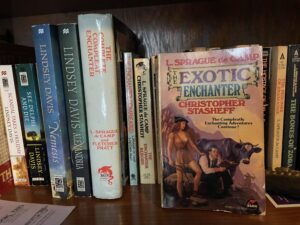
Here we are with part 4 of my look at the Harold Shea stories. The last part, as far as I am aware. The Exotic Enchanter returns L. Sprague de Camp and Christopher Stasheff to the series as well as adding three additional authors, two of whom co-write a story. The ongoing pursuit of Florimel continues to drive the narrative for a while. As motivations go it is serviceable — it certainly has the benefit of experience behind it. So, on to the first story.
Enchanter Kiev by Roland Green and Frieda Murray. Perhaps not the most clever of titles, but at least it provides a notion of where the characters will find themselves. I’m familiar with Roland Green as a competent adventure scribbler, but I do not recall running across Frieda Murray before. This tale follows up the cliff hanger from the previous volume. Shea and Chalmers are either in Borodin’s opera, Prince Igor, or in the earlier, inspirational work, The Lay of Igor’s Host. Other than some slight knowledge of the period and the area, this is new literary territory for me. The story is fine. It lacks some of the clarity other others have brought to the series. If it isn’t exactly murky, the prose could at times be clearer. Lacking also is the gift of de Camp and Pratt’s I noted in an earlier post: pacing. This one could do with tightening up. It crawls at times, burdened with excess detail. The writers, I guess, wanted to show their work.
Sir Harold and the Hindu King, by Christopher Stasheff. I’m unfamiliar with the tale sends Drs. Shea and Chalmers into. There is early promise of a certain whimsical humor. Sadly that largely vanishes, followed with the occasional droll observation but little actual levity. That’s too bad; the Prophet of Profit was a fun character from whom the reader is led to expect repeat visits. The story becomes rather turgid and I had to push myself to finish it. It isn’t a bad story, merely lackluster. At least the pursue of Florimel storyline is wrapped up. Finally.
Sir Harold of Zodanga. L. Sprague de Cap is back! And with a story set in Edgar Rice Burroughs’ Barroom! Expectations mount. de Camp answers one question I had about the continuity of a series written over 50 years. It seems that, instead of maintaining a 1940s timeline, de Camp envisions a comic book style continuity in which everything occurs in a continuously flowing now. Thus this story occurs in the 1990s. The story sees Malambroso kidnapping Shea and Belphebe’s daughter and spiriting her off to Barroom. The couple pursues. It is fun to step back onto ERB’s red planet again, though through another author’s filter. In this case the filter is de Camp. Those still irritated at de Camp and Carters’ approach to Robert E. Howard’s Conan oeuvre will likely bristle immediately. de Camp, being who he is, cannot help but “correct” the technical deficiencies of ERB’s science fiction, frequently noting that such things as radium guns were merely exaggerations or inaccuracies on the part of the scrivener of John Carter’s adventures. And that was okay with me, having had some of the same quibbles. At least, okay for a while until it seemed to entirely preoccupy de Camp at the expense of the story. He decamped from grounds of gentle, affectionate teasing into full on Neil deGrasse Tyson territory, apparently abandoning all sense of whimsy and acceptance of fantastic literature conventions. Still the best of the stories so far, and fun when de Camp focused on the adventure.
Harold Shakespeare by Tom Wham. I’m not familiar with Wham’s work. In the culminating tale he takes Shea, Belphebe, and Polacek (remember him?) onto the island of Shakespeare’s The Tempest prior to the advent of Prospero. While it could have been paced a trifle faster it remained engaging. I would have preferred interaction with the great wizard himself, perhaps a brush or two with Caliban. But the story works well enough. Much of the formula is in evidence, though I could have wished Wham would have had Shea working through the science of the magic of this particular world, rather than rehashing the greatest hits of other stories. I suppose this story is in fact a respectful homage. It does serve as sort of coda, wrapping up the series, and reestablishing all the major characters more or less comfortably back in Ohio.
And that, so far as I know, is that for Harold Shea. Is anyone aware of another collection, or perhaps an uncollected story or two? To sum up four posts worth of reviews: the truth is that the real sparkle vanished without Fletcher Pratt. The collaboration of Pratt and de Camp just worked. Every Harold Shea story after varied in quality from mediocre to slightly above average.
For the concluding, commercial portion of the post, I’ll recommend a thematically appropriate work. I wrote Under Strange Suns in part as an homage to ERB’s Barroom. Give it a try.

2 comments
There is one more story set in the “Enchanter” multiverse, “Return to Xanadu,” (2005, by Lawrence Watt-Evans. It appeared in the Harry Turtledove-edited The Enchanter Completed: A Tribute Anthology for L. Sprague de Camp (Baen Books, 2005). Watt-Evans revisits the Kubla Khan-based universe, but none of the main protagonists reappear; instead, the story concentrates on a concubine who had taken a shine to Walter Bayard while he was trapped there. She turns out to be in the wrong world herself, belonging in that of the 1,000 and 1 Nights. A helpful wizard (modeled on de Camp himself) helps her get there. Regarding de Camp’s Barsoomian revisionism, there’s a bit of fan fiction (by me) that addresses it, and can be read on the ERBzine site. It’s a sequel to “Sir Harold of Zodanga” in the form of a play, titled “The Prisoner of Zodanga.” I postulate that Shea experiences Barsoom differently from how Burroughs’s heroes did because he is partially misalligned to that universe, as Chalmers was in the world of “Knight and the Enemy.”
Thank you. I have some things to track down, then.